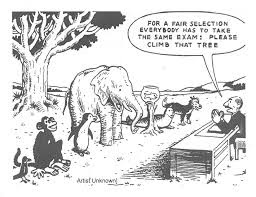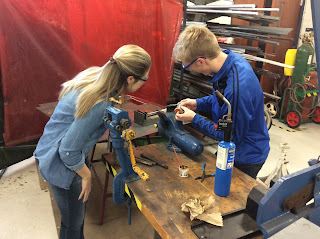Differentiating Instruction
"Choice makes the young adolescent's desire for control and freedom possible- without the power struggle. Choice builds confidence and fosters independence. Choice tells students their interests are important and allows them to demonstrate responsibility." - Hume. No two students are the same, their learning capacity and style mimics those differences. Allowing students to make choices in their individualized learning helps to reach of their learning needs. Student's learning can be catagorized through readiness, interests, and learning preferences.

Student readiness. Each student needs to be evaluated individually to understand where each student is coming from academically. Just like in this cartoon every animal is not capable of climbing the tree, it is my job as an educator to overcome those obstacles.
Interests. Each student has their own interests, connecting those interests to concepts creates a deeper interest in the content being learned.
Learning preferences. Students have many different ways of taking in information and processing it. Understanding those different processes plays a large role in differentiating instruction.
Taking these categorizing into account for each individual learner will allow for a focal point of differentiated instruction. However, there should be the same common learning goal for the class as a whole, unless noted by an IEP.
Agricultural education allows many students to focus and learn through their interests and learning preferences. I look forward to creating an understanding for student readiness, interests, and learning preferences through SAE visits and working hands on next to students. In my future classroom I foresee a need to understand my students learning needs and providing learning opportunities through those needs.
Thinking ahead to who I will be as an educator I found this example to be extremely helpful in providing examples of differentiating instruction. Most of all I found it is important to always be prepared no matter the individual teaching technique I chose to use.
________________________________________________________________________________________
EduGains. (2015). Reach every student through differentiated instruction. Retrieved from http://www.edugains.ca/resourcesDI/Brochures/DIBrochureOct08.pdf



Student readiness. Each student needs to be evaluated individually to understand where each student is coming from academically. Just like in this cartoon every animal is not capable of climbing the tree, it is my job as an educator to overcome those obstacles.
Interests. Each student has their own interests, connecting those interests to concepts creates a deeper interest in the content being learned.
Learning preferences. Students have many different ways of taking in information and processing it. Understanding those different processes plays a large role in differentiating instruction.
Taking these categorizing into account for each individual learner will allow for a focal point of differentiated instruction. However, there should be the same common learning goal for the class as a whole, unless noted by an IEP.
Agricultural education allows many students to focus and learn through their interests and learning preferences. I look forward to creating an understanding for student readiness, interests, and learning preferences through SAE visits and working hands on next to students. In my future classroom I foresee a need to understand my students learning needs and providing learning opportunities through those needs.
Thinking ahead to who I will be as an educator I found this example to be extremely helpful in providing examples of differentiating instruction. Most of all I found it is important to always be prepared no matter the individual teaching technique I chose to use.
________________________________________________________________________________________
EduGains. (2015). Reach every student through differentiated instruction. Retrieved from http://www.edugains.ca/resourcesDI/Brochures/DIBrochureOct08.pdf



Comments
Post a Comment